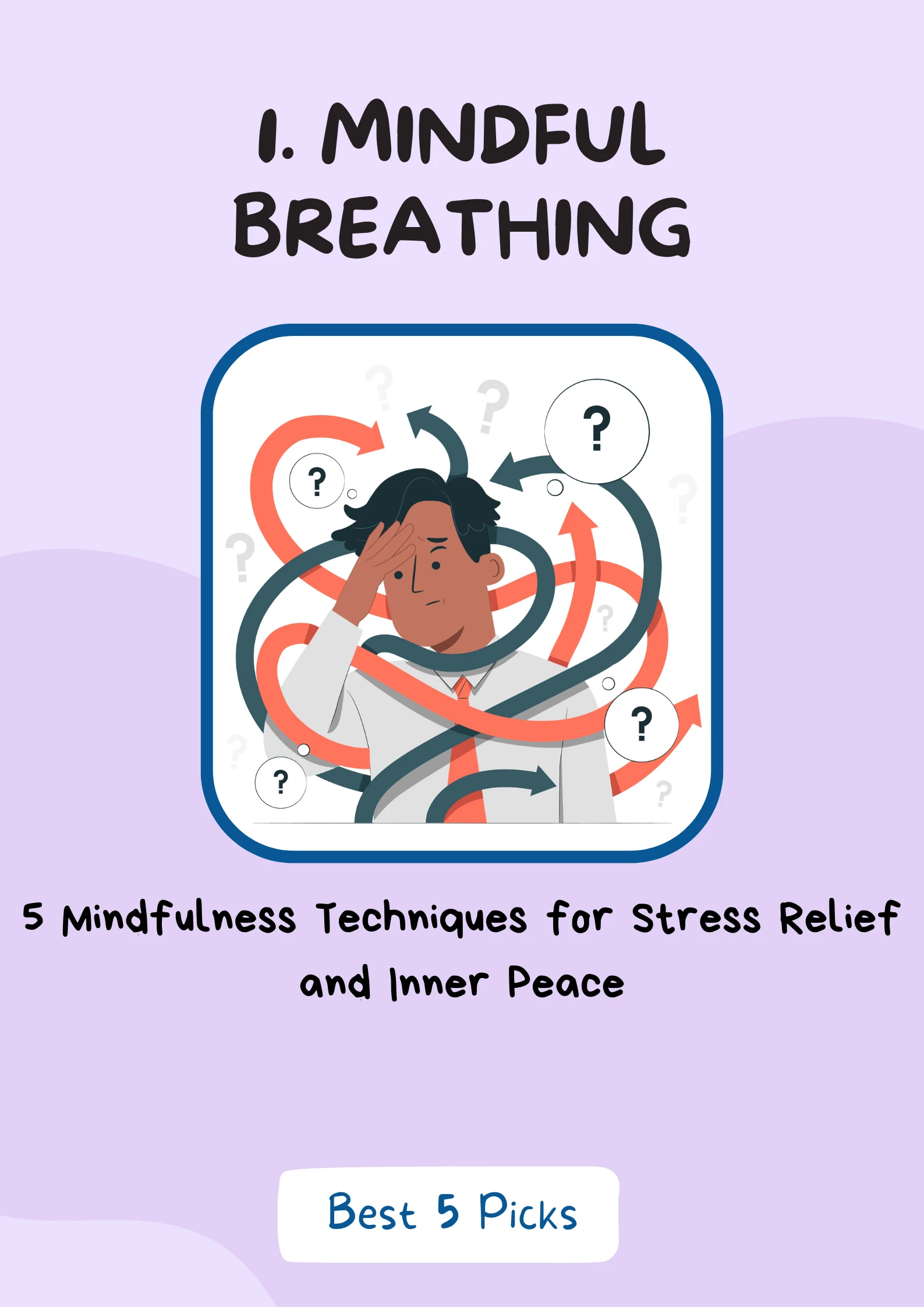Looking to alleviate stress in your life? Dive into this insightful article exploring Five Stress Management Techniques.
Discover practical strategies designed to help you navigate life’s challenges with ease.
Whether it’s mindfulness practices, physical activity, or relaxation techniques, you’ll find actionable tips to cultivate a sense of calm amidst the chaos.
In today’s fast-paced world, stress can often feel overwhelming. However, by incorporating these proven stress management techniques into your daily routine, you can take proactive steps towards better mental and emotional well-being.
Learn how to harness the power of your mind and body to reduce stress and live a more balanced life.
I. Introduction
Unlock Inner Peace: 5 Stress Management Techniques That Actually Work! Discover expert tips now. Say goodbye to stress!
A. Definition of mindfulness
- Mindfulness is the practice of being fully present and aware of one’s thoughts, feelings, bodily sensations, and the surrounding environment without judgment.
- It involves paying attention to the present moment with openness, curiosity, and acceptance.
B. Importance of mindfulness for stress relief and inner peace
- Mindfulness has gained significant attention in recent years due to its proven effectiveness in reducing stress and promoting inner peace.
- In today’s fast-paced and demanding world, stress has become a common problem that affects both physical and mental well-being.
- Mindfulness helps individuals manage stress by cultivating a greater sense of self-awareness and providing tools to respond to stressors more effectively.
- By practicing mindfulness, individuals can develop resilience, improve focus and concentration, enhance emotional regulation, and experience a greater sense of inner calm and peace.
- Mindfulness enables individuals to break free from automatic and reactive patterns of thinking, allowing them to respond to challenges with clarity and equanimity.
- Ultimately, mindfulness empowers individuals to live more fully in the present moment, leading to a deeper connection with themselves and the world around them.
5. Mindful Eating

A. Explanation of the Technique
Mindful eating is a practice that involves bringing full awareness and attention to the process of eating. It emphasizes being present in the moment and experiencing the sensations, flavors, and textures of the food.
In today’s fast-paced world, many people tend to eat quickly and mindlessly, often multitasking or eating on the go. This can lead to overeating, poor digestion, and a disconnect from the body’s natural hunger and fullness cues.
Mindful eating encourages a more conscious and intentional approach to food. It is rooted in the principles of mindfulness, which involve non-judgmental awareness and acceptance of the present moment.
By applying mindfulness to eating, individuals can develop a healthier relationship with food, enhance their overall well-being, and find greater enjoyment in their meals.
The practice of mindful eating involves several key elements:
1. Awareness of Hunger and Fullness: Mindful eating starts with tuning in to the body’s signals of hunger and fullness. Before eating, take a moment to check in with your body and assess whether you are truly hungry or if you are eating out of habit, boredom, or emotional reasons. Throughout the meal, pay attention to the body’s cues of fullness and stop eating when you feel satisfied.
2. Engaging the Senses: Mindful eating encourages you to engage all of your senses while eating. Take the time to appreciate the colors, shapes, and aromas of your food. Chew slowly and savor each bite, noticing the flavors and textures as you eat. By focusing on the sensory experience, you can derive more satisfaction from your meals and feel more connected to the process of nourishing your body.
3. Non-Judgmental Observation: Practice observing your thoughts, emotions, and judgments that arise while eating, without attaching any value to them. Notice any tendencies to label certain foods as “good” or “bad” and let go of any guilt or shame associated with eating. Cultivating a non-judgmental attitude allows for a more compassionate and accepting relationship with food.
4. Mindful Food Choices: Mindful eating also involves making conscious choices about the types of foods you consume. Consider the nutritional value and how certain foods make you feel. Aim to include a variety of whole, unprocessed foods that nourish your body and provide sustained energy. However, it’s also important to allow for occasional indulgences and enjoy them mindfully without guilt.
5. Eating Environment: Pay attention to the environment in which you eat. Create a calm and peaceful space, free from distractions such as screens or work-related activities. By creating a dedicated space for eating, you can fully focus on the experience and promote a sense of relaxation and enjoyment.
By practicing mindful eating, individuals can develop a healthier relationship with food, cultivate self-awareness, and improve overall well-being. It can also help with weight management, digestion, and emotional eating patterns. Incorporating mindful eating into daily life may require patience and practice, but over time it can become a natural and enjoyable habit.
Remember, mindful eating is not about perfection or strict rules. It’s about developing a mindful mindset around food, fostering self-compassion, and building a sustainable and nourishing relationship with what you eat.
B. Benefits of Mindful Eating
Mindful eating is a practice that involves paying full attention to the eating experience, focusing on the present moment, and cultivating a non-judgmental awareness of the sensations, tastes, and thoughts associated with eating.
This practice has numerous benefits for both physical and mental well-being. Let’s explore some of the significant benefits of mindful eating:
1. Improved Digestion: When we eat mindfully, we tend to slow down and thoroughly chew our food. This allows for better digestion and nutrient absorption. By savoring each bite and fully experiencing the taste and texture of food, we enhance the body’s digestive processes, leading to improved overall digestion.
2. Weight Management: Mindful eating can be a powerful tool for weight management. By eating mindfully, we become more aware of our body’s hunger and fullness cues. This awareness helps us distinguish between true hunger and emotional or mindless eating. By listening to our body’s signals, we are more likely to eat when we are genuinely hungry and stop eating when we are satisfied, thus preventing overeating.
3. Increased Satisfaction: Mindful eating promotes a greater sense of satisfaction and enjoyment during meals. By being fully present and engaged in the eating experience, we savor the flavors, textures, and aromas of food. This heightened sensory experience enhances the pleasure we derive from eating, making each meal more satisfying.
4. Enhanced Mind-Body Connection: Mindful eating cultivates a stronger mind-body connection. By paying attention to our body’s sensations, we become more attuned to its needs and signals. We develop a deeper understanding of how different foods affect us, both physically and emotionally. This awareness empowers us to make conscious choices that support our overall well-being.
5. Reduced Emotional Eating: Mindful eating can help break the cycle of emotional eating. Instead of using food as a means to cope with stress, boredom, or other emotions, we learn to recognize and address our emotional needs directly. By bringing awareness to our emotions and developing healthier coping strategies, we can reduce the tendency to turn to food for emotional comfort.
6. Enhanced Gratitude and Appreciation: Mindful eating encourages a sense of gratitude and appreciation for the food we eat. By recognizing the effort, resources, and labor involved in producing our meals, we develop a deeper appreciation for the nourishment provided by food. This gratitude fosters a positive relationship with food and promotes a sense of interconnectedness with the world around us.
7. Reduced Stress and Anxiety: Engaging in mindful eating can have a calming effect on the mind and body. By focusing on the present moment and letting go of distractions, we create a space for relaxation and stress reduction. The practice of mindfulness during meals helps shift our attention away from worries, allowing us to experience a sense of inner peace and tranquility.
Incorporating mindful eating into our daily lives can transform our relationship with food and bring about positive changes in our overall well-being. By slowing down, being fully present, and savoring each bite, we nourish not only our bodies but also our minds and souls.
With practice, mindful eating can become a natural and enjoyable way of nourishing ourselves, fostering a deeper connection to our bodies and the world around us.
C. Step-by-step instructions for practicing mindful eating
Practicing mindful eating can transform your relationship with food and help you cultivate a deeper sense of awareness and enjoyment during meals. Here are some step-by-step instructions to guide you in incorporating mindful eating into your daily routine:
1. Create a Peaceful Environment: Before you begin your meal, take a moment to create a calm and inviting environment. Set the table neatly, dim the lights, and eliminate distractions such as electronic devices or television. This will allow you to focus solely on the experience of eating.
2. Engage Your Senses: Take a moment to appreciate the appearance, aroma, and colors of your food. Observe the textures, shapes, and arrangement on your plate. This step helps to activate your senses and prepares you to fully engage in the eating experience.
3. Express Gratitude: Before taking your first bite, express gratitude for the nourishment in front of you. This can be a silent acknowledgment or a brief moment of reflection to cultivate a sense of appreciation for the food and those involved in its production.
4. Slow Down: As you begin eating, consciously slow down your pace. Take smaller bites and chew each mouthful thoroughly before swallowing. Pay attention to the flavors, textures, and sensations that arise with each bite. Slowing down allows you to savor the food and enhances your awareness of the experience.
5. Observe Your Body: Throughout the meal, periodically check in with your body. Notice the physical sensations of hunger, fullness, and satisfaction. Pay attention to how your body responds to different foods and flavors. This self-awareness can help guide your choices and prevent overeating.
6. Be Present: Practice being fully present during the meal. Avoid multitasking or engaging in distracting thoughts. Instead, focus your attention on the act of eating, relishing each moment. If your mind starts to wander, gently bring it back to the present moment and the food in front of you.
7. Cultivate Mindful Choices: While practicing mindful eating, make conscious choices about the types and amounts of food you consume. Consider the nutritional value, your body’s needs, and your preferences. Allow yourself to indulge in treats occasionally, but be mindful of how they make you feel.
8. Listen to Your Body’s Signals: Pay attention to your body’s signals of satiety and fullness. Stop eating when you feel satisfied rather than overly stuffed. This mindful awareness of your body’s needs will help you develop a healthier and more balanced relationship with food.
9. Practice Gratitude: At the end of the meal, take a moment to express gratitude once again. Reflect on the nourishment you received and the experience of mindful eating. Appreciate the opportunity to nourish your body and cultivate a sense of inner peace.
Remember, practicing mindful eating is a journey and may require some time and patience to fully integrate into your routine. As you continue to engage in this practice, you will gradually develop a deeper connection with your body, food, and overall well-being.
4. Loving-Kindness Meditation

A. Explanation of the Technique
Loving-kindness meditation, also known as metta meditation, is a powerful mindfulness practice that cultivates feelings of love, compassion, and kindness towards oneself and others.
It originates from Buddhist traditions but has gained popularity across various cultures and religions due to its transformative effects on emotional well-being and relationships.
The primary objective of loving-kindness meditation is to develop a genuine sense of benevolence, empathy, and goodwill towards all beings. It involves directing positive intentions and wishes for happiness, peace, and joy to oneself, loved ones, acquaintances, strangers, and even to those we may perceive as difficult or challenging.
The practice typically starts with focusing on oneself and gradually extends to others, ultimately encompassing all living beings. It emphasizes the understanding that all individuals, regardless of their background or circumstances, deserve love and compassion.
During a loving-kindness meditation session, practitioners use repetitive phrases or mental intentions to cultivate feelings of warmth and kindness. These phrases can be personalized, but they often follow a general pattern.
Some examples include:
1. May I be happy, healthy, and safe.
2. May my loved ones be happy, healthy, and safe.
3. May all beings in the world be happy, healthy, and safe.
The phrases may vary, and practitioners are encouraged to choose ones that resonate with them personally. The important aspect is to generate genuine feelings of well-wishing and compassion.
Remember, loving-kindness meditation is a skill that develops with consistent practice. It is a profound way to cultivate compassion, love, and inner peace, not only for oneself but also for the benefit of the world. Incorporating this practice into your
B. Benefits of loving-kindness meditation
Loving-kindness meditation, also known as metta meditation, is a powerful practice that cultivates feelings of love, compassion, and kindness towards oneself and others. By directing well-wishes and positive intentions, this technique has numerous benefits for one’s emotional well-being and overall inner peace.
Let’s explore some of the significant benefits of loving-kindness meditation:
1. Increases Positive Emotions: Regular practice of loving-kindness meditation helps generate feelings of love, kindness, and compassion. It allows individuals to tap into their innate capacity for empathy and fosters a deep sense of connection with themselves and others. As a result, one experiences an overall increase in positive emotions such as happiness, joy, and gratitude.
2. Reduces Negative Emotions: This meditation technique is particularly effective in reducing negative emotions, such as anger, resentment, and envy. By actively cultivating feelings of love and compassion, individuals can gradually let go of negative emotions and develop a more compassionate and forgiving outlook towards themselves and others.
3. Enhances Relationships: Loving-kindness meditation nurtures qualities that are essential for healthy and harmonious relationships. Regular practice helps improve communication, empathy, and understanding, fostering deeper connections with others. It can also heal strained relationships by promoting forgiveness and acceptance.
4. Cultivates Self-Compassion: One of the fundamental aspects of loving-kindness meditation is directing loving-kindness towards oneself. It encourages individuals to treat themselves with kindness, acceptance, and forgiveness. Practicing self-compassion through loving-kindness meditation can reduce self-criticism and promote a healthier self-image.
5. Reduces Stress and Anxiety: Engaging in loving-kindness meditation activates the body’s relaxation response, leading to a reduction in stress and anxiety levels. By focusing on positive emotions and releasing negative thoughts, individuals experience a sense of calmness and tranquility. This practice also helps individuals develop resilience and cope better with challenging situations.
6. Improves Overall Well-being: Regular practice of loving-kindness meditation has a positive impact on overall well-being. It promotes emotional stability, increases self-esteem, and enhances overall mental health. The practice can also improve sleep quality and boost energy levels, contributing to a greater sense of inner peace and happiness.
7. Cultivates Empathy and Compassion: Loving-kindness meditation is a powerful tool for developing empathy and compassion towards others. It allows individuals to see beyond differences and judgments, fostering a sense of interconnectedness and unity. By cultivating compassion, individuals are more likely to engage in acts of kindness and contribute to a more compassionate and supportive society.
Incorporating loving-kindness meditation into your daily routine can have a profound impact on your emotional well-being and inner peace. As you engage in this practice, remember to be patient and gentle with yourself, allowing the feelings of love and compassion to naturally arise.
With time and dedication, loving-kindness meditation can transform your relationship with yourself and others, leading to a more fulfilling and harmonious life.
C. Step-by-step instructions for practicing loving-kindness meditation
Loving-kindness meditation, also known as metta meditation, is a powerful practice that cultivates feelings of love, compassion, and goodwill towards oneself and others. It can help reduce stress, foster inner peace, and enhance emotional well-being.
Here are step-by-step instructions to guide you through a loving-kindness meditation practice:
1. Find a quiet and comfortable space: Begin by finding a peaceful environment where you can sit or lie down without distractions. Choose a posture that feels comfortable for you, whether it’s sitting cross-legged on the floor or sitting upright in a chair.
2. Set your intention: Take a moment to reflect on your intention for the meditation practice. It could be a desire to cultivate love, compassion, or inner peace within yourself and extend it to others.
3. Start with self-compassion: Begin by directing loving-kindness towards yourself. Close your eyes and bring your attention to your heart center. Repeat silently or aloud phrases such as “May I be happy, may I be healthy, may I be safe, may I live with ease.” Allow these phrases to resonate within you, genuinely wishing yourself well-being.
4. Extend loving-kindness to a loved one: Visualize someone you deeply care about, such as a close friend, family member, or mentor. Hold their image in your mind and repeat the same phrases of loving-kindness towards them. Imagine sending them warmth, love, and good wishes.
5. Expand to neutral individuals: Shift your focus to individuals who are neither close nor distant from you—people you may encounter in your daily life, such as neighbors, colleagues, or acquaintances. Wish them well by repeating the phrases of loving-kindness. Cultivate a sense of connection and goodwill towards them, even if you don’t know them personally.
6. Extend loving-kindness to difficult people: This step can be challenging but transformative. Bring to mind someone with whom you have had difficulty or conflict, someone who may have caused you pain or frustration. While it may be difficult, try to hold them in a space of compassion and understanding. Offer them the same loving-kindness phrases, recognizing that everyone seeks happiness and freedom from suffering.
7. Expand to all beings: In this final stage, extend your loving-kindness to all living beings, regardless of their relationship to you. Envision a world filled with love, compassion, and peace. Repeat the phrases of loving-kindness, embracing all beings and wishing them well-being, happiness, and peace.
8. Closing the practice: Gradually bring your awareness back to your body and the present moment. Take a few deep breaths, feeling the sensations in your body. Gently open your eyes, allowing yourself to reorient to your surroundings.
Remember, loving-kindness meditation is a practice, and it may take time to experience its full benefits. Consistency and patience are key. As you continue this practice, you may notice a shift in how you relate to yourself and others, fostering a greater sense of inner peace, compassion, and connectedness.
Incorporating loving-kindness meditation into your daily routine can be a powerful tool for reducing stress and promoting overall well-being.
Give yourself the gift of cultivating love and compassion within, and watch as it ripples outward, positively impacting your relationships and the world around you.
3. Mindful Walking

A. Explanation of the Technique
Mindful walking is a powerful mindfulness practice that involves bringing your full attention and awareness to the act of walking. It allows you to cultivate a sense of presence, connect with your body and surroundings, and find inner peace.
Unlike regular walking, which is often done automatically and without much awareness, mindful walking encourages you to slow down and engage all your senses in the experience.
To practice mindful walking, find a quiet and peaceful location where you can walk without distractions. It could be a park, a beach, or even a quiet street with little traffic.
Mindful walking can be practiced for short periods of time, such as during a break or as part of a longer meditation session. Regular practice can help reduce stress, increase self-awareness, and promote a sense of well-being. It allows you to reconnect with your body, nature, and the present moment, leading to a greater sense of inner peace and harmony.
B. Benefits of Mindful Walking
Mindful walking is a simple yet powerful mindfulness technique that involves bringing your attention to the present moment while walking. By consciously focusing on the sensations of walking, you can cultivate a sense of calm, reduce stress, and experience inner peace.
Here are some of the key benefits of incorporating mindful walking into your daily routine:
1. Stress Reduction: Mindful walking is an excellent way to alleviate stress. As you walk, you can redirect your attention away from the thoughts and worries that may be causing stress, and instead focus on the physical sensations of each step. This shift in attention helps to relax the mind and reduce anxiety, allowing you to experience a greater sense of calm.
2. Improved Mental Clarity: Engaging in mindful walking can enhance mental clarity and focus. By grounding your attention in the present moment, you become more aware of your surroundings and the sensations in your body. This increased awareness helps to clear your mind of distractions and promotes a sharper and more focused mental state.
3. Enhanced Physical Well-being: Mindful walking is not only beneficial for your mental health but also for your physical well-being. Regular walking is known to improve cardiovascular health, boost metabolism, and strengthen muscles. When combined with mindfulness, walking becomes an opportunity to nourish both your body and mind simultaneously.
4. Connection with Nature: Mindful walking offers a chance to connect with the natural environment around you. As you walk, take notice of the sights, sounds, and smells of nature. Engaging your senses in this way can be soothing and grounding, fostering a sense of harmony and peace within yourself and with the world around you.
5. Increased Self-Awareness: Mindful walking encourages self-reflection and self-awareness. By focusing on your body’s movements, you become more attuned to your physical sensations, thoughts, and emotions. This heightened self-awareness allows you to observe your inner experiences without judgment, leading to a greater understanding of yourself and your reactions to the world.
6. Mind-Body Integration: Walking mindfully brings together the body and mind in a harmonious way. By synchronizing your steps with your breath and being fully present in the act of walking, you create a state of balance and integration between your physical and mental states. This integration promotes a sense of wholeness and inner peace.
Incorporating mindful walking into your daily routine can have profound positive effects on your overall well-being. Whether you choose to walk in nature, in a park, or simply around your neighborhood, take the opportunity to slow down, observe, and fully experience each step.
By making mindful walking a regular practice, you can cultivate a greater sense of calm, reduce stress, and find inner peace in the midst of your daily life.
C. Step-by-step instructions for practicing mindful walking
1. Find a peaceful location: Choose a quiet and serene location for your mindful walking practice. It could be a park, a beach, or any other natural setting that appeals to you. Ensure that you have enough space to walk comfortably without distractions.
2. Stand tall and relax: Begin by standing upright with your feet shoulder-width apart. Let your arms hang naturally by your sides. Close your eyes or lower your gaze, and take a few deep breaths to center yourself and relax your body.
3. Bring awareness to your body: Slowly shift your attention to the sensations in your body. Feel the contact of your feet with the ground, the weight of your body being supported, and the subtle movements of your muscles as you stand.
4. Start walking slowly: Begin to walk at a slow, leisurely pace, maintaining a relaxed posture. Be mindful of each step you take. Feel the sensation of your feet touching the ground, the shifting of your weight from one foot to the other, and the gentle movements of your legs.
5. Focus on your breath: As you continue walking, bring your attention to your breath. Notice the rhythm and depth of your inhalations and exhalations. Let your breath guide your steps, syncing your movement with your breath.
6. Engage your senses: Open your senses to the environment around you. Notice the sights, sounds, and smells that surround you. Observe the colors, textures, and shapes of nature. Listen to the sounds of birds chirping or leaves rustling. Engage with the present moment through your senses.
7. Stay present: Whenever your mind starts to wander or thoughts arise, gently bring your focus back to the present moment. Use the sensation of your footsteps or the rhythm of your breath as anchors to keep your attention grounded.
8. Cultivate gratitude and appreciation: As you walk, take moments to express gratitude for the simple joys and beauty around you. Appreciate the gift of movement and the connection with nature. Let gratitude fill your heart as you continue your mindful walking practice.
9. Walk with intention: Walk purposefully and with intention, as if each step is meaningful. Avoid rushing or trying to reach a particular destination. Instead, savor the journey and the process of walking itself.
10. End mindfully: When you feel ready to conclude your mindful walking practice, slow down gradually and come to a gentle stop. Take a moment to acknowledge the experience and the benefits it brought you. Express gratitude for the opportunity to practice mindfulness.
Mindful walking can be a powerful practice for cultivating present-moment awareness, reducing stress, and fostering a sense of inner peace.
Incorporate this technique into your routine regularly, and you will discover the transformative effects it can have on your overall well-being.
2. Body Scan Meditation

A. Explanation of the technique
Body scan meditation is a mindfulness practice that involves systematically directing your attention to different parts of your body, bringing awareness to physical sensations, and promoting a sense of relaxation and connection with your body.
This technique is often used to reduce stress, release tension, and cultivate a deeper sense of self-awareness. By focusing your attention on different areas of the body, you can develop a greater understanding of the mind-body connection and bring a sense of calm and balance into your life.
The body scan meditation can be done in a seated or lying-down position, whichever is most comfortable for you. It is recommended to find a quiet and peaceful space where you can dedicate uninterrupted time to this practice.
By regularly practicing body scan meditation, you can cultivate a greater sense of embodiment, reduce stress, and foster a deeper connection with yourself. Remember, this technique is a journey, and each time you practice, you can deepen your awareness and experience the benefits of this powerful mindfulness technique.
B. Benefits of Body Scan Meditation
Body scan meditation is a mindfulness technique that involves systematically bringing awareness to each part of the body, from head to toe, and observing any sensations, tensions, or areas of discomfort.
This practice has numerous benefits for stress relief and inner peace. Let’s explore some of the key benefits of body scan meditation in detail:
1. Deep Relaxation: Body scan meditation promotes deep relaxation by allowing you to release physical tension and mental stress.
As you focus your attention on each part of the body, you become more aware of any areas of tightness or discomfort. Through gentle and non-judgmental observation, you can consciously release these tensions, leading to a state of deep relaxation and calmness.
2. Heightened Body Awareness: This meditation technique enhances your body awareness. Many of us live in a state of disconnectedness from our bodies, often neglecting physical sensations until they become intense or painful.
Body scan meditation cultivates a sense of deep connection with your body, enabling you to notice subtle changes and signals it sends. This heightened awareness can help you address any physical discomfort or stress before it escalates.
3. Stress Reduction: Regular practice of body scan meditation can significantly reduce stress levels. By scanning each body part and observing the sensations without judgment, you learn to develop a non-reactive and accepting attitude toward your physical experiences.
This non-judgmental awareness helps you develop resilience and cope with stress more effectively, as you become less entangled in negative thoughts or physical discomfort.
4. Improved Mind-Body Connection: Body scan meditation strengthens the connection between your mind and body. As you bring your attention to different body parts, you begin to notice how your thoughts, emotions, and physical sensations are interconnected.
This heightened awareness allows you to recognize the impact of your mental state on your physical well-being. By nurturing a harmonious mind-body connection, you can enhance your overall sense of well-being and inner peace.
5. Enhanced Self-Care: Engaging in body scan meditation promotes self-care and self-compassion. By devoting time to explore and observe your body, you send a powerful message of care and attentiveness to yourself.
This practice encourages you to treat your body with kindness and respect, fostering a deeper sense of self-love and acceptance. As a result, you are more likely to prioritize self-care practices and make healthier choices in your daily life.
6. Improved Sleep Quality: Body scan meditation can also have a positive impact on your sleep quality. The deep relaxation and heightened body awareness induced by this practice help to calm the mind and release physical tension before bedtime.
By incorporating body scan meditation into your nighttime routine, you can experience more peaceful and restful sleep, waking up refreshed and rejuvenated.
Body scan meditation offers a wide range of benefits for stress relief and inner peace. From deep relaxation and heightened body awareness to stress reduction and improved self-care, this practice can transform your relationship with your body and enhance your overall well-being.
By dedicating a few minutes each day to body scan meditation, you can cultivate a greater sense of calmness, self-compassion, and harmony between your mind and body.
C. Step-by-step instructions for practicing body scan meditation
Body scan meditation is a powerful mindfulness technique that helps you cultivate a deep connection with your body, release tension, and promote relaxation. By systematically bringing attention to different parts of your body, you can develop a heightened awareness of physical sensations and gain a sense of inner peace. Here are step-by-step instructions to help you practice body scan meditation effectively:
1. Find a quiet and comfortable space: Choose a peaceful environment where you can sit or lie down without any distractions. Ensure that you are in a position that allows your body to relax fully.
2. Assume a comfortable posture: Whether you choose to sit or lie down, make sure your body is in a comfortable and relaxed position. Close your eyes gently or keep them softly focused on a spot in front of you.
3. Bring your attention to your breath: Take a few moments to focus on your natural breath. Observe the sensation of the breath as it enters and leaves your body. Allow your breath to anchor you in the present moment.
4. Start the body scan: Begin directing your attention to different parts of your body, starting from the top of your head and moving downwards towards your toes. You can imagine a gentle wave of relaxation flowing through each area you focus on.
5. Notice physical sensations: As you bring your attention to each body part, notice any physical sensations present in that area. It could be warmth, tension, tingling, or any other sensations. Observe without judgment or the need to change anything.
6. Release tension: If you notice any areas of tension or discomfort, consciously relax those muscles. With each exhale, visualize releasing any tension or tightness you may be holding.
7. Move slowly and mindfully: Progress through the body parts slowly, taking your time with each one. It’s normal for your mind to wander, but gently guide your attention back to the body part you are focusing on without judgment.
8. Cultivate a sense of gratitude: As you scan each part of your body, bring a sense of appreciation and gratitude for the functioning of your body. Acknowledge the incredible gift of having a healthy body.
9. Conclude with an overall body awareness: After scanning all the individual body parts, take a few moments to bring your attention to your body as a whole. Feel the sensations of your body, the weight, and the contact with the surface beneath you.
10. Gradually transition back: When you’re ready to end the practice, slowly bring your awareness back to your breath. Take a few deep breaths, gently wiggle your fingers and toes, and open your eyes.
By regularly practicing body scan meditation, you can cultivate a deeper mind-body connection and promote relaxation and inner peace.
Remember that this is a skill that develops over time, so be patient with yourself and allow the practice to unfold naturally.
With consistent effort, body scan meditation can become a valuable tool for stress relief and cultivating a greater sense of well-being.
1. Mindful Breathing

A. Explanation of the Technique
Mindful breathing is a simple yet powerful technique that can help alleviate stress and promote inner peace. It involves focusing your attention on the breath, bringing awareness to each inhale and exhale.
By directing your attention to the present moment and the sensations of your breath, you can cultivate a sense of calm and relaxation.
The technique of mindful breathing is rooted in the practice of mindfulness, which involves non-judgmental awareness of the present moment. It draws inspiration from ancient meditation traditions, particularly from Buddhist teachings, but has gained popularity in modern wellness practices due to its effectiveness in reducing stress and promoting overall well-being.
The idea behind mindful breathing is to anchor your attention to the breath, using it as an anchor to the present moment. The breath acts as a constant and accessible point of focus, allowing you to detach from racing thoughts, worries, or distractions. By observing your breath without judgment, you develop a greater sense of self-awareness and learn to embrace the present moment with acceptance.
Mindful breathing has numerous benefits for both mental and physical well-being. It helps activate the body’s relaxation response, reducing the production of stress hormones and promoting a state of calm. Regular practice of mindful breathing can lead to improved concentration, enhanced emotional regulation, and increased resilience in the face of stressors.
To practice mindful breathing, find a comfortable seated position, either on a chair or on the floor with crossed legs. Close your eyes or maintain a soft gaze, and bring your attention to your breath.
Observe the sensation of the breath as it enters and leaves your body. Notice the rise and fall of your abdomen or the feeling of air passing through your nostrils. If your mind wanders, gently redirect your attention back to the breath without judgment.
You can also incorporate mindful breathing into your daily routine. Take a few moments before starting a task or during a break to focus on your breath. Pay attention to the physical sensations and the rhythm of your breathing. By integrating this practice into your day, you can experience the benefits of mindfulness and bring a sense of peace and clarity to your life.
Mindful breathing is a powerful technique for stress relief and inner peace. By bringing awareness to your breath and the present moment, you can reduce stress, enhance self-awareness, and cultivate a sense of calm. With regular practice, mindful breathing can become a valuable tool in managing stress and promoting overall well-being.
B. Benefits of Mindful Breathing
Mindful breathing is a powerful mindfulness technique that involves paying deliberate attention to the breath. By focusing on the breath, you bring your awareness to the present moment, allowing yourself to let go of distractions and worries.
This simple practice can have profound effects on your overall well-being, offering numerous benefits for stress relief and inner peace.
1. Stress Reduction: One of the primary benefits of mindful breathing is its ability to reduce stress. When you practice mindful breathing, you activate the relaxation response in your body, which counteracts the stress response. This helps to lower your heart rate, reduce blood pressure, and decrease the levels of stress hormones in your system. Regular practice of mindful breathing can help you manage stress more effectively and improve your overall resilience.
2. Emotional Regulation: Mindful breathing is closely linked to emotional regulation. When you pay attention to your breath, you become more aware of your thoughts, emotions, and physical sensations without judgment. This awareness allows you to observe your emotions as they arise, rather than getting caught up in them. By developing this skill, you gain greater control over your emotional responses and can respond to challenging situations with more clarity and composure.
3. Increased Focus and Concentration: Mindful breathing enhances your ability to concentrate and stay focused. As you practice directing your attention to the breath, you train your mind to remain anchored in the present moment. This cultivates mental clarity and reduces distractions, allowing you to stay fully engaged in your tasks or activities. Improved focus can lead to enhanced productivity, better decision-making, and a greater sense of accomplishment.
4. Relaxation and Inner Peace: Engaging in mindful breathing promotes deep relaxation and a sense of inner peace. By bringing your attention to the breath, you tap into a natural rhythm that is calming and soothing. This practice encourages a state of relaxation throughout your body and mind, helping you to unwind and let go of tension. Regular practice of mindful breathing can create a lasting sense of tranquility and contentment.
5. Improved Physical Well-being: Mindful breathing not only benefits your mental and emotional well-being but also has positive effects on your physical health. Deep and intentional breathing increases the oxygen flow to your body, nourishing your cells and organs. It can boost your immune system, improve digestion, and promote better sleep. Additionally, mindful breathing has been shown to reduce symptoms associated with chronic pain and enhance overall vitality.
Incorporating mindful breathing into your daily routine can have profound effects on your overall quality of life. The benefits mentioned above are just a glimpse of what this practice can offer. By dedicating a few moments each day to mindful breathing, you can experience increased calmness, resilience, and a deeper connection with yourself and the world around you.
C. Step-by-step instructions for practicing mindful breathing
Practicing mindful breathing is a simple yet powerful technique that can help you calm your mind, reduce stress, and find inner peace. By focusing your attention on your breath, you can bring yourself into the present moment and cultivate a sense of tranquility. Here are the step-by-step instructions for practicing mindful breathing:
1. Find a quiet and comfortable space: Start by finding a peaceful environment where you can sit comfortably without any distractions. It could be a quiet room in your home, a serene spot in nature, or even a designated meditation area.
2. Assume a comfortable posture: Sit in a relaxed position, either on a cushion or a chair. Keep your back straight but not rigid, allowing your body to be at ease. Rest your hands on your lap or place them on your knees, whatever feels comfortable for you.
3. Close your eyes or soften your gaze: To minimize external visual distractions, gently close your eyes. If you prefer to keep them open, lower your gaze and focus on a neutral point in front of you.
4. Bring your attention to your breath: Begin by taking a few deep breaths to relax your body. Then allow your breath to return to its natural rhythm. Shift your focus to the sensation of your breath as it enters and leaves your body.
5. Observe the breath: Direct your attention to the physical sensations associated with breathing. Notice how the air feels as you inhale through your nostrils, and how it warms up as you exhale. You may also become aware of the rise and fall of your abdomen or the expansion and contraction of your chest.
6. Stay present with each breath: Maintain your focus on the breath, experiencing each inhalation and exhalation fully. If your mind starts to wander, gently acknowledge any thoughts or distractions that arise, and then gently bring your attention back to your breath without judgment.
7. Embrace the present moment: As you continue to observe your breath, be fully present in the moment. Let go of any worries, regrets, or future-oriented thoughts. Allow yourself to be immersed in the sensations of breathing, finding a sense of calm and stillness within.
8. Practice for a few minutes: Begin with a few minutes of mindful breathing and gradually increase the duration over time. Aim to practice this technique for at least 5-10 minutes daily, or longer if you have the opportunity.
Remember, the goal of mindful breathing is not to control or manipulate your breath, but to observe it as it naturally occurs. It is normal for your mind to wander during the practice, so be patient and gently guide your attention back to the breath whenever you notice distractions.
By incorporating mindful breathing into your daily routine, you can cultivate a greater sense of awareness, reduce stress, and foster inner peace.
Take a few moments each day to connect with your breath, and you’ll discover the transformative power of this simple yet profound practice.
II. Conclusion
In this article, we have explored five mindfulness techniques that can significantly contribute to stress relief and inner peace. Let’s recap each technique briefly:
1. Mindful Breathing: This technique involves focusing your attention on your breath, observing its natural rhythm, and allowing it to anchor you to the present moment. Mindful breathing helps calm the mind, reduce anxiety, and increase self-awareness.
2. Body Scan Meditation: Body scan meditation involves systematically directing your attention to different parts of your body, noticing physical sensations, and cultivating a non-judgmental awareness of your body. It promotes relaxation, reduces tension, and enhances mind-body connection.
3. Mindful Walking: Mindful walking entails walking slowly and deliberately, paying attention to the sensations in your feet, legs, and body as you move. It encourages grounding, improves focus, and allows you to experience the present moment through the act of walking.
4. Loving-Kindness Meditation: This technique involves cultivating feelings of love, compassion, and kindness towards oneself and others. Through the use of positive affirmations and visualizations, loving-kindness meditation nurtures empathy, fosters emotional well-being, and promotes a sense of interconnectedness.
5. Mindful Eating: Mindful eating involves savoring each bite of food, being fully present with the sensory experience, and paying attention to the taste, texture, and smell of the food. It helps develop a healthier relationship with food, promotes mindful choices, and encourages gratitude for nourishment.
A. Encouragement to Incorporate Mindfulness into Daily Life for Stress Relief and Inner Peace
In our fast-paced and often hectic lives, stress and inner turmoil can easily take over. However, by incorporating mindfulness techniques into our daily routines, we can cultivate a greater sense of calm, clarity, and inner peace.
Practicing mindfulness doesn’t require a significant time commitment or specialized equipment. It can be integrated seamlessly into everyday activities, such as during meals, walks, or moments of solitude. By taking a few minutes each day to engage in these mindfulness techniques, we can experience their transformative effects on our overall well-being.
III. Quick Recap of Top 5 Stress Management Techniques
- Mindful Breathing
- Body Scan Meditation
- Mindful Walking
- Loving-Kindness Meditation
- Mindful Eating
It is important to remember that mindfulness is a skill that develops over time with consistent practice. Start small and gradually increase the duration and frequency of your mindfulness sessions. Be patient with yourself and approach each practice with an open mind and non-judgmental attitude.
By making mindfulness a part of your daily life, you can reduce stress, increase self-awareness, and cultivate a greater sense of inner peace. Embrace the present moment, cherish the simple pleasures of life, and nurture your overall well-being through the power of mindfulness.
IV. Frequently Asked Questions (FAQ)
What exactly is mindfulness and how does it help with stress?
Mindfulness is the practice of being present and fully engaged in the moment. It helps with stress by allowing us to acknowledge our thoughts and feelings without judgment, which can reduce anxiety and promote a sense of calmness.
How does mindful breathing help in managing stress?
Mindful breathing involves focusing on your breath, which can help calm the mind and reduce stress. By paying attention to the sensations of breathing, you can anchor yourself in the present moment and alleviate tension.
Can you explain what a body scan meditation is and how it works?
Body scan meditation involves systematically focusing on different parts of the body, noticing any sensations without judgment. It helps to increase awareness of bodily tension and promotes relaxation, which can reduce stress levels.
Is mindful walking just taking a stroll, or is there more to it?
Mindful walking involves paying close attention to each step, the sensations in your feet, and the surrounding environment. By practicing mindfulness while walking, you can relieve stress and enhance your connection with the present moment.
What is loving-kindness meditation, and how does it relate to stress management?
Loving-kindness meditation involves cultivating feelings of compassion and goodwill towards oneself and others. By fostering positive emotions, this practice can counteract stress, promote emotional resilience, and improve overall well-being.
How does mindful eating differ from regular eating habits?
Mindful eating involves paying full attention to the sensory experience of eating, including the taste, texture, and smell of food. By eating slowly and mindfully, you can enhance enjoyment, make healthier food choices, and reduce stress related to eating.
Can these mindfulness techniques be practiced by anyone, regardless of experience?
Yes, mindfulness techniques can be practiced by anyone, regardless of experience. They involve simple exercises that can be adapted to individual preferences and needs.
How long do I need to practice mindfulness techniques to see results in stress reduction?
The amount of time needed to see results can vary from person to person. Consistent practice over time is key, but even short sessions of mindfulness can provide immediate relief from stress.
Are there any potential side effects or risks associated with practicing mindfulness techniques?
Generally, mindfulness techniques are safe for most people. However, some individuals may experience discomfort or emotional intensity when confronting their thoughts and feelings. It’s essential to approach these practices with self-compassion and seek guidance if needed.
Can mindfulness techniques replace other forms of stress management, such as therapy or medication?
Mindfulness techniques can complement other forms of stress management, but they may not be a complete replacement for therapy or medication, especially for those with severe or chronic stress. It’s essential to consult with a healthcare professional to determine the best approach for your individual needs.










